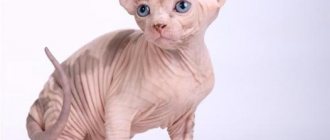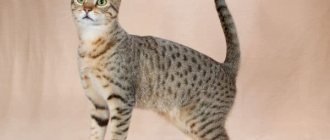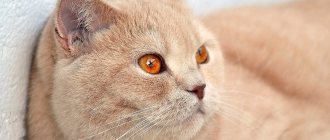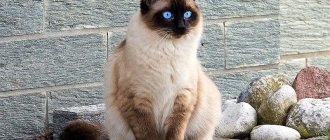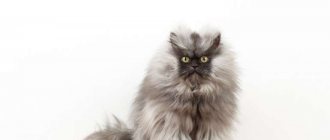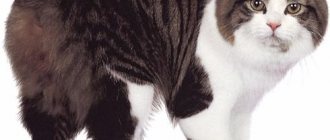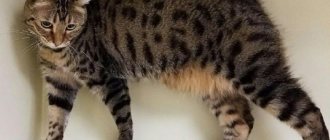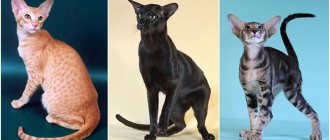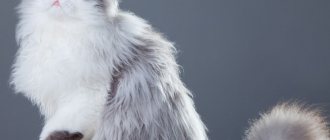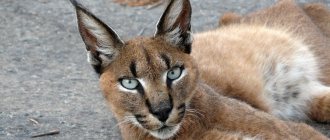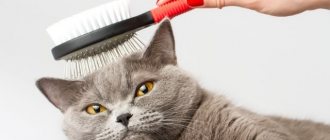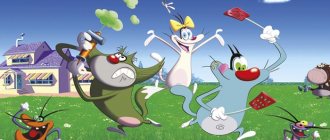Origin story
The starting point in the development of the breed is considered to be 2005: it was then that the Osborne couple from Arkansas acquired an unusual-looking kitten: tiny, with short legs and a complete absence of hair on the body. The baby was named Bambino for his sweet appearance.
Time passed, the kitten grew, but remained the same miniature and short-legged. The couple realized that the matter was clearly a genetic mutation, and decided to try to establish a new breed.
Experimentally, it was possible to find out that the parents of the first bambino were munchkins and Canadian sphinxes. The work began to boil and already in 2005 the first “samples” began to appear at exhibitions. The breed received experimental status and geneticists were involved in the matter.
Many people condemn such crossing: it is believed that interspecific breeding is unsafe for the offspring, causing external deformities and genetic abnormalities. However, the bambino had so many fans that the social activists were unable to stop the work. They started breeding these cats in Russia, and at the same time. But, since they had no family ties with the Osborne pets, the breed line received its own special set of genes.
A bambino cat is expensive: a pet cat will cost about 90-100 thousand rubles, a breeding cat will cost over 200 thousand rubles. An elite cat will cost a cosmic sum. Also take into account upcoming expenses on food, cat cosmetics, etc.
Health
The bambino breed was bred quite recently - in 2005, so there is no data on their life expectancy. Felinologists say that on average they will live 13 - 15 years, but with good care they can live up to 18 - 20 years.
Bambinos, unfortunately, do not have a strong enough immune system, so you need to keep the house clean and prevent them from interacting with foreign animals - they can easily catch an infection. It is also important to get vaccinated in a timely manner.
As for the special structure of the cat's skeleton, surprisingly, there are no problems with this, unlike the dachshund and basset hound, which are often paralyzed due to pinched vertebrae. Bambinos, like munchkins, have a very flexible and mobile spine.
There is not yet enough data on genetic diseases, but felinologists say that bambinos are prone to developing cardiomyopathy, which was passed on to them from sphinxes. With this disease, the wall of the heart ventricle thickens, resulting in its volume becoming smaller. As a result, the amount of blood that can be pumped per heartbeat decreases. The disease has no cure; the veterinarian can only prolong the cat’s life by prescribing medications. The consequence of the pathology is chronic heart failure and death of the cat. Even with the help of ultrasound, any pathological changes are not always detected, so it is better to initially ask the breeder to confirm that the kitten’s parents are healthy. In the early stages of the disease, there are no characteristic symptoms; in an advanced state: shortness of breath, weakness, and sometimes paralysis of the limbs.
Another common bambino disease is Malassezia dermatitis. The causative agent is the yeast fungus Malassezia. It is present on the skin of healthy cats, but under favorable conditions (poor hygiene, stress, hypothermia) it begins to multiply. The first signs: severe itching, inflammation, redness, alopecia, damage to the claws (a brown coating appears). Your cat may have an unpleasant sweet odor.
The disease is easily diagnosed: laboratory specialists will take a scraping from the skin and examine it for pathogenic microflora. Treatment should be prescribed by a veterinarian. Usually the cat is washed with antifungal shampoo and wiped with chlorhexidine or a weak solution of acetic acid. These substances create unfavorable conditions for fungal growth. Antimycotic creams or ointments (Candide, Clotrimazole, Miconazole and others) are also applied to the affected areas.
Standards
Bambino cats are elegant and graceful creatures, although not without features that are unusual for the human eye. Outwardly, they resemble dachshunds: they are just as long, strong, with a rounded back and a belly as round as a ball. They weigh little: 2.5-4.5 kg. Females are visually smaller than males.
| Standard | Description |
| Head | Wedge-shaped, with a straight nose (the stop is barely visible) and prominent cheekbones (the pinch underneath is clearly visible). The whisker pads are dense, plump, the whiskers are broken, and the chin is clearly defined. The ears are large, wide at the base and rounded at the tips. The inside of the auricle is smooth, hairless, and covered with flock on the outside. |
| Eyes | They are shaped like a lemon, placed at a distance from each other and noticeably squinted. The iris can be anything, but a mandatory requirement is to match the color of the coat. |
| Torso | Elongated, with strong bones and a broad chest, chiseled shoulders and a massive neck. |
| Limbs | Short but strong, the front ones are visually longer than the front ones. The toes are long, graceful and very flexible. The pads are elastic and plump. The tail is of medium length with a tassel at the tip. |
| Wool | It may or may not be present (gummi type). The body feels like velor to the touch. |
The bambino's skin is very thick and wrinkled. The neck, muzzle, shoulder area and between the ears have the most folds.
Exterior
In appearance, bambinos are very similar to the Canadian Sphynx. They have the same muzzle, identical body structure, and coat quality. Only the length of the limbs differs.
Bambino is often compared to a dachshund due to its short legs and elongated body.
Thick paw pads are a distinctive feature of the bambino.
Possible defects:
- frail physique, underdeveloped muscles;
- defects in the structure of the tail (kinks, fused vertebrae);
- short body;
- excessive amount of hair.
The color point color is found not on a milky, but on a gray background. The gray monochromatic body color is very beautiful. The white color is the most popular. A black cat is a valuable specimen for breeders. Bambinos have multi-colored eyes (heterochromia)
Character and behavior
The character of the Bambino matches its name: cats of this breed are infinitely kind and devoted to their owners. They have no desire to hunt at all, therefore, no matter who lives in your house - a chattering parrot, a panting hedgehog, a restless hamster, another cat or dog - the bambino will quickly find a common language with him. Do not let your cat walk alone: he is in danger in the form of unfriendly animals. Bambino will not be able to repel an opponent even of his own size, so do not let your pet out of sight.
A smart and quick-witted bambino quickly learns all the rules of the house in which he lives. He runs to his litter box not only when he needs to, but also when he feels sick, so buy a container with low sides so that it is convenient for him to climb into it.
They love people and company, feel extremely uncomfortable alone and begin to break into closed doors with all their might. These are eternal children: they need constant attention, affection, lots of toys and control. Curious cats can jump from a height, stick their nose into a hot oven, try an electric wire on their teeth - in general, they have plenty of worries. Sometimes their attention is attracted by things that other cats are not interested in, so hide small and dangerous things away.
Breeding
Crossbreeding two adult bambinos on your own is unacceptable; it is dangerous due to the appearance of mutations in kittens. The breeding of this breed is always accompanied by professional geneticists and felinologists. You can purchase kittens of this breed in nurseries: Mirmagnificent (Sochi, Russia), Shococats, Joser (Moscow, Russia); LilNudists, Forest For Film, Kyty Kittens (USA).
You can buy a bambino kitten in a nursery in Moscow or Sochi
It is not safe to buy bambino kittens by hand. The point is not only that they may have mutations or diseases, but that scammers often pass off the Canadian Sphynx as a bambino, which significantly affects the price of the animal. In this case, you can overpay several times, and the cat will not grow up to be what you expected it to be.
Care instructions
Bathing
These babies should be bathed regularly 2-3 times a week, or even more often (depending on the intensity of sebum secretion). When it accumulates on the skin, it causes an unpleasant odor, so when you bring home a new resident, immediately buy a special shampoo for cats. If your pet has a cold and cannot be bathed, use wet wipes (without alcohol or fragrance) to clean it.
To make the animal comfortable during the procedure, lay a thick diaper in the bath or place a rubberized mat. Then the cat will not slide its paws along the bottom. The water temperature is no higher and no lower than +23-25 degrees.
Ears
The ears are cleaned once a week using a cotton swab and chlorhexidine. Eyes - daily in the same way. Teeth – 2 times a month using cat toothpaste and a brush (you can also buy a children’s brush).
Claws
If a cat sharpens its claws on its own, it will not need your help. Otherwise, trim the claws once a week with a nail clipper, being careful not to damage the blood vessels or scratch the skin on the paw.
Do you trim your pet's nails?
Yes, he’s lazy with us. No, he sharpens himself.
Basic information
| Breed name: | Bambino |
| Country of origin: | USA, Osborne |
| Period of appearance of the breed: | 1999 |
| Type: | Home |
| Average weight: | 2.5 - 5 kg |
| Height at withers: | 10-20 cm |
| EMS code: | BMB |
| Average life expectancy: | 7 – 15 years |
| Prices for kittens: | 100 — 1050 $ |
Catering
Accelerated metabolism is another feature of bambino cats, but this also poses a danger, namely gluttony, which can lead to obesity and related problems. Therefore, do not react to your cat’s plaintive meowing and paw slap on an empty bowl: feed her exactly as much as required by her weight, and do not indulge her with snacks between main meals.
Keep bowls clean. They need to be washed after every meal and the water changed 2 times a day in the mornings and evenings.
Kittens up to 4 months eat 6 times a day, over six months - 3-4 times, over a year - at least 3 times.
At first, feed the baby the same thing that the breeder fed him, and introduce new food gradually. Whether you switch it to natural food from industrial food or vice versa - it doesn’t matter, the main thing is that the products must be of high quality, without chemical additives. What is suitable for humans is not suitable for animals, so remember a few nutritional rules.
Natural products
Bambino cats, like other cats, should not be fed from your table. Human food - fried potatoes, rolls, fatty soups, etc. - causes serious health problems in animals. But they don’t taste sweets at all, they can eat it with great appetite and become seriously poisoned in the future.
The basis of natural nutrition is lean meat, dairy products, cereals, vegetables and eggs. Meat (beef, veal, rabbit, turkey, lamb) should first be kept in the freezer for a couple of days, and scalded with boiling water or boiled before serving.
It is mixed with porridge cooked in water (oatmeal, rice, corn, buckwheat, millet or semolina), adding some vegetables (zucchini, pumpkin, carrots, beets, beans), fresh herbs (parsley, dill, green salad) and a spoon of any vegetable oil (sunflower, olive, flaxseed).
3-4 times a week the cat should be given dairy products: hard unsalted cheese, cottage cheese, yogurt, fermented baked milk, natural yogurt. From time to time, meat can be replaced with offal, stewed chicken hearts, liver, gizzards, ground into minced meat. The eggs are boiled and only the yolk is given from chicken eggs, whole quail eggs.
The following products should not be given:
- Salted (including pure salt), smoked, pickled, fatty;
- Condiments, sauces, spices, seasonings, aromatic herbs;
- Offal, lard, bones (including boiled chicken, especially dangerous);
- Potatoes, tomatoes, eggplants, fruits (exception: apples, pears, melons and watermelons);
- Human drinks;
- Dog food.
Recommended food
Economy class cat food: Wellkiss, TerraCot, 365 days.
Premium: Zoogurman, Mnyams, Native food.
Super premium: Pronature Life, Summit, Vet Life.
Holistic: Orijen, Power of Nature, Wildcat.
Below are recommended super-premium foods. Links with the names of the food are clickable, on them you can, within our website, read the descriptions of the food and read reviews from owners of Bambino cats.
| Premium | Super premium | Economy |
| Sirius | Leonardo | Perfect Fit |
The vitamin and mineral complex is selected taking into account the individual needs and parameters of the animal (age, weight, activity, concomitant diseases, etc.). Popular: “Agrovetzaschita”, “Farmaks”, “8 in 1”, “BEAPHAR”, “Doctor ZOO” can be bought at any veterinary pharmacy. In addition to vitamins, the cat should be given dry brewer's yeast in courses, according to the instructions.
How to choose a kitten
The breed is experimental, so choosing a kitten must be approached with all responsibility. In particular, you can seek help in choosing from experienced felinologists. In any case, be sure to independently study the documents and reviews about the nursery.
Important! It is necessary to carefully study the documents for the kitten, its pedigree, and the parents’ permission to breed. The breed was bred with two genetic mutations - dwarfism and lack of hair. Improper breeding of this breed guarantees health problems for kittens.
You can only buy a kitten from professional nurseries. If a kitten is purchased for breeding, carefully study the terms of the contract separately and record all the details in writing with the breeder.
Since the breed is a rare and exotic breed, the cost of kittens is quite high and starts from 2-3 thousand dollars abroad, the price in Russia is from 50 thousand rubles.
The unusual color and the classification of the kitten as a breed or show class will directly affect how much the kitten will cost. If you want to buy a kitten just as a pet and are not going to breed the breed, then a pet class kitten will save money.
Diseases
Bambinos are not long-livers: today, since the breed is still very young, the upper limit does not exceed 12 years. But everything can change: breeders are confident that if the breed is rid of hereditary problems, individuals will be able to live several years longer.
We managed to overcome the first problem, or rather, learn to cope with it with minimal losses. We are talking about hypertrophic cardiomyopathy - a pathology of the heart muscle that leads to the sudden death of a pet at a very young age. Most often, the disease occurs in males.
The animal becomes lethargic, refuses to play and does not want to run, it develops shortness of breath and coughing, fainting, and paralysis of the limbs. This pathology was inherited from the Canadian Sphynx and, unfortunately, it is impossible to cure it. But improving the quality of life with the help of drug therapy and regular medical supervision is quite possible.
The second problem also causes bambino owners a lot of trouble: weak immunity. Breeders especially recommend that owners not allow pets to come into contact with street animals, and also carefully plan the menu and ensure that the animal does not become hypothermic.
Expert opinion
Dusheba Vera Ivanovna
In 2010, she graduated from the Moscow State Academy of Veterinary Medicine named after K.I. Scriabin with honors, specializing in veterinary medicine. I regularly attend veterinary conferences, congresses, and webinars.
Many felinologists believe that the use of immunomodulators is not justified: they are expensive and do not have the desired effect. In any case, only a doctor should prescribe them.
Naturally, you should not refuse preventive vaccinations: against rabies, panleukopenia, calcivirosis, and the like. These diseases can lead to the death of your pet, and you can easily introduce pathogens into your home on your hands or the soles of your shoes. Please remember that you cannot:
- Use low-quality vaccines or expired vaccines;
- Vaccinate cats weakened after illness, exhausted, wormed (with the exception of extreme necessity), pregnant and lactating females, and babies;
- Individuals who have been in contact with suspicious and sick animals.
Vaccination against shingles is not mandatory, but is advisable if your cat lives in the same room as a dog.
Female bambinos successfully give birth and raise their offspring. Cats reach sexual maturity at 7-8 months, but it is better to introduce them to a cat within a year and a half. Usually no more than 4 kittens are born in a litter (every 4th embryo does not survive when mating such miniature individuals). If you do not plan to breed, have your cat spayed. “Empty” heats often lead to the formation of tumors.
Mister Cat Recommends: Temperament Features
Bambinos have a unique character. These cheerful and kind cats never show aggression towards anyone. Therefore, they easily get along with any pets - their other brothers, dogs, birds, guinea pigs. They will not hunt a parrot or a mouse.
These kids will play for the rest of their lives. They adore the owner and all household members, especially children.
They are smart, highly trainable, and able to remember simple commands.
Short legs do not prevent pets from running and jumping. Bambinos maintain an active lifestyle even into old age.
They like to sit on their hind legs with their front legs folded over their chest. The “dreamer” pose, the prerogative of the Sphinxes, is also characteristic of them.
They do not tolerate loneliness well. They are happy to accompany their owner on trips and travels.
Feeding the cat
To ensure that the short-legged hairless cat receives all the necessary vitamins and minerals, he is provided with a balanced diet. Many breeders recommend feeding bambino high-quality premium or super-premium dry food.
When choosing a brand, you should give preference to products from trusted global manufacturers, which do not add soy, corn, dyes or preservatives. The following foods fully meet these criteria:
- Royal Canin;
- Farmina;
- Pro Plan;
- Gemon.
If a bambino eats natural foods, its diet should contain at least 70% meat. Twice a week, chicken, beef or turkey is replaced with ocean fish and offal. Also, representatives of the Bambino cat breed must be given vegetables, eggs, cereals and dairy products.
In order not to harm the animal, the following are completely excluded from its diet:
- fat meat;
- river fish;
- sweets;
- smoked meats;
- baking;
- sausages;
- any food from the master's table.
Estimation of breed characteristics
| Adaptability: |
| Shedding level: |
| Social need: |
| Grooming: |
| Ease of care: |
| Attachment to family: |
| Hair loss/shedding: |
| Predisposition to diseases: |
If sphinxes do not seem very attractive, it is worth getting acquainted with representatives of the bambino breed. They appeared recently, but their exceptionally cute appearance and excellent character quickly make them popular. When making a purchasing decision, you need to find out everything about the breed of these hairless cats so that the surprises are only pleasant.
